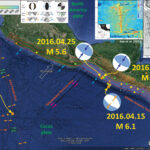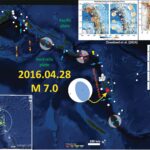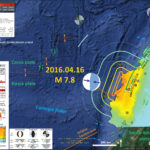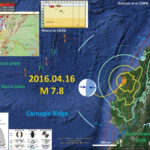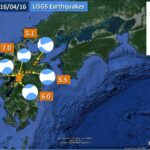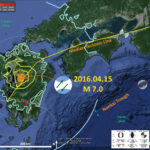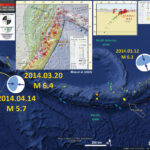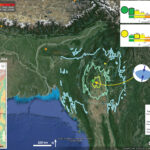Yesterday we had an earthquake along the Clipperton fracture zone (CFZ), a transform plate boundary that offsets the northern East Pacific Rise (EPR). I was busy grading so did not get to this until today. Here are the four large…
Earthquake Report: Vanuatu!
We just had a large earthquake in the Vanuatu region, just south of a series of earthquakes from a couple weeks ago. Here is the USGS website for today’s M 7.0 earthquake. I include some figures and animations that I…
Earthquake Anniversary: M 7.8 Gorkha (Nepal) Earthquake
An anniversary is for the Gorkha (Nepal) Earthquake from 1 year ago. I have several Earthquake Reports listed below. These include a variety of observations and comparisons with historic and prehistoric earthquakes that I compiled. USGS slip models: http://earthjay.com/?p=2478 First…
Earthquake Report: Ecuador Update #1
Here is an update to my preliminary report about the M 7.8 subduction zone earthquake in Ecuador. Here is my first report. More information about this earthquake is on that report page. Here is the USGS website for the M…
Earthquake Report: Ecuador!
We just had a large earthquake along the coast of Ecuador. Here is the USGS website for the M 7.8 earthquake. Below is my Earthquake Report Poster. I plot the USGS moment tensor for this earthquake, along with the Modified…
Earthquake Report: Japan Update #2
Here is an update to the seismicity from the past couple of days in Kyushu Japan. On 2016/04/14 there was an earthquake with magnitude M 6.2 that initiated this series of earthquakes. The largest aftershock was a magnitude M 6.0.…
Earthquake Report: Kyushu, Japan!
As I was preparing an aftershock map for yesterday’s earthquake, an earthquake with a magnitude of M = 7.0 happened. This turns all other earthquakes into foreshocks, though this terminology may not really be important (foreshock vs aftershock). The M…
Earthquake Report: Kyushu, Japan!
We just had a shallow depth earthquake in Japan along a strike-slip fault. Here are the USGS websites for the larger earthquakes in this region for today. 2016.04.14 M 6.2 2016.04.14 M 6.0 2016.04.14 M 5.3 Below is the Earthquake…
Earthquake Report: Kamchatka!
A couple weeks ago, there was an earthquake with a magnitude of M 6.4 and today there was an earthquake with a magnitude of M 5.7. I had not put together a report for the M 6.4, so this report…
Earthquake Report: Burma!
Here is my preliminary earthquake report. There was an earthquake with a magnitude of M 6.9 in Burma. Here is the USGS web page for this earthquake. Based upon the modeling, this appears to likely be a very damaging earthquake…

